Review for Shaolin
Introduction
If ever there was a word with connotations, it's 'Shaolin'. The first time I heard it was back in 1986, when I got hold of a Spectrum arcade conversion called Shaolin Road. It wasn't the most inspired beat-'em-up ever, but I got enough enjoyment out of it for the title to stick in my mind. It was only later, when I discovered the wonders of Hong Kong cinema that I got some idea of what Shaolin actually was, an order of warrior monks synonymous with kung fu. If you think of Hong Kong action cinema, the first word that will spring to mind will be kung fu (I never actually realised that the monks in the David Carradine Kung Fu series were actually Shaolin monks, oddly enough), and the second word will most likely be Shaolin. To date, I have reviewed four films with the word Shaolin in the title, two of them starring Jackie Chan. There is the iconic Shaolin Wooden Men, as well as Snake and Crane Arts of Shaolin. The less said about The Young Hero of Shaolin Part 2 the better, while Shaolin Soccer put a wholly unique spin on things.
The real Shaolin temple (there actually is one) has decided to regain some control over how their name is used, they've gotten trademarked and copyrighted, and now only a film that gets their endorsement and blessing can carry the word Shaolin in its title. My fifth Shaolin movie, and the third with Jackie Chan in, is named, quite simply Shaolin, and Cine Asia are bringing it to the UK in shiny Blu-ray form, as well as your usual DVD release. It's a period kung fu flick, as so many of them are, but the period that Shaolin chooses, the Republic Era (which thanks to Bey Logan's commentary I can tell you is between 1912 and 1928) is an interesting one. It's where traditional kung fu techniques go up against modern warfare, guns and artillery, wielded by power hungry warlords.
For the warlord General Hou Jie, life really couldn't be better. He's just taken control of the city of Tengfeng in Henan, and his army's rapacious expansion seems to know no bounds. He'll even pursue a fallen foe into the Shaolin temple to ensure that he is dead, arrogantly contemptuous of the temple's claim to be the birthplace of kung fu, or the fact that it is holy ground. But sating his lust for power means dealing with the devil, in this case foreign devils that want to swap guns for the right to exploit the Chinese mainland, and rival warlords, some of whom are enemies, and some that are sworn brothers. General Sung even wants to cement their alliance by betrothing their children. But Hou's paranoia overwhelms him when his right hand man, Cao Man comes to him with rumours that Sung is preparing to betray him. Hou decides to strike first, but it is a trap.
Broken and bereft, torn from his family, and pursued as a fugitive, Hou Jie winds up at the doorstep of the very same Shaolin temple that he so scornfully derided. Tragically brought face to face with the depths of his avarice, he'll have to learn from the Shaolin monks, embrace their principles, and burn away the trappings of his old existence if he is to find redemption, and some measure of solace. Fortunately he finds the oddest of teachers, the temple cook, who nurses him back from his grief, and puts him on the righteous path. But the world outside is getting even worse for the people of Henan, for the man that displaced Hou Jie, Cao Man has embraced the foreigners and the weapons they bring, and to sate their greed, he's working the peasants to death. He's learned how to be ruthless from the best, and it will be down to Hou Jie to undo the damage that he is indirectly responsible for.
Picture
I'm still at the stage where Blu-ray transfers blow me away, and Shaolin's 2.35:1 widescreen 1080p transfer is no exception, looking astounding on this disc. It's clear, sharp and colourful throughout, with rich and lustrous detail, bringing across the amazing costume and set design, the stunning location filming. The period look gives the film a colour timing which is ever so slightly sepia toned, rich in browns, greys and an overall grimy realistic feel. The action sequences are stupendously choreographed and staged, and this is probably the first Chinese film that I have seen that has its CGI enhancements completely invisible to the viewer's eye, so well does it blend its special effects with its in camera work. If I were picking nits, I did notice some macroblocking or rather colour banding, when Hou Jie was in a boar trap looking up at the night sky, and the variations in black were uneven, but that is all.
Sound
Naturally the audio track to opt for here is the DTS-HD MA Mandarin 5.1 Surround track, which delivers effective and beefy surround for the action sequences, accurately reproduces the music of the film, and has the dialogue clear and audible throughout. English subtitles are provided, and they are legible, free of error and accurately timed. Shaolin also boasts a DD 5.1 English audio track, at some 640 kbps (my player only shows the bitrate in Mb and rounds up or down), and my disdain for English dubs meant that I only listened long enough to ensure its existence. One problem with the English track is that there is no signs only subtitle track to translate any on screen captions, you'll have to flick on the main subtitle stream for that.
Extras
The Blu-ray is packed as always with extra features, courtesy of Cine Asia, and once more, the Blu-ray even gets more than the 2-disc DVD release.
The film gets animated menus, and here you'll find the Trailer Gallery for the film, with the UK trailer and 3 domestic trailers.
In the Also Available section, you'll find twelve other trailers for Cine Asia product.
In the Languages and Subtitles Menu, you'll be able to access the Bey Logan audio commentary for the film, and once again it is the pinnacle of audio commentaries, offering so much pertinent information, background to the film, biographies of the actors that you will most likely have to listen to it twice to take it all in. What I always find amazing is that Bey Logan not only delivers this treasure trove of information, but he also manages to be affable, interesting and entertaining.
The rest of the extras are, quite appropriately, in the special features menu.
The Making Of Gallery has nine featurettes in, running to a total of 40 minutes. The only substantial one is the one confusingly titled The Making Of, which lasts 24 minutes. All the others are brief featurettes running to two minutes apiece, and looking at small aspects of the film, like the building of the set, some of the stunt set pieces, and the young actors in the film.
The Interviews Gallery is more substantial, with some 15 pieces in, running to a total of 132 minutes. Some of the actors are even interviewed twice, once in Cantonese, and once in Mandarin, and as you can imagine there may be a bit of repetition here. All the stars, Andy Lau, Jackie Chan, Wu Jing, Nicholas Tse, Fan Bingbing and the director Benny Chan all contribute. The problem here is that some of the interviews are sloppily edited together, sometimes just three or four word chunks, cutting out all the ums and ahs to get to the meat of what an interviewee is saying. That means that the interview in question becomes a rapid series of jump cuts, bloody distracting and difficult to watch. Were the interviews in English, I could just close my eyes and listen, but that isn't an option here. Particularly afflicted are the Mandarin interview with Andy Lau, the Nicholas Tse interview, the Xiong Xinxin and Fan Bingbing interviews, and the first Benny Chan interview.
The Behind The Scenes Gallery lasts 65 minutes, and there are looks at the filming of 20 scenes, some of them deleted from the film. It's all b-roll footage, without the commentary or voiceover to put what is happening in context, but it's easy enough to figure out just by watching it.
All this material is shared with the DVD release, and is presented in SD PAL format.
The following material is Blu-ray exclusive, and is in HD.
Usually Deleted Scenes are superfluous, and it's easy to see why they were deleted. Not so with the 44 minutes of deleted scenes that come with Shaolin, 10 scenes in total. Some are indeed delete-worthy, some add nothing to the film but are fun to look at, but many of them build and flesh out the characters, and in particular add to Hou Jie's journey from warlord to repentant monk. Apparently they were cut at an early enough point for ADR to be incomplete, and special effects yet to be added, but they would have been better in the film, even if it would have pushed the run time past the two and half hours mark.
Not only a Blu-ray exclusive, but a Cine Asia exclusive as well, Shaolin Wushu in action takes us behind the scenes of a Shaolin Wushu Centre in Los Angeles, where students learn the skills developed and perfected by the Shaolin monks. The instructors and the students speak and there are plenty of demonstrations of the art form as well. This lasts 33 minutes.
Conclusion
Why is it that the idea of an action movie somehow precludes depth, intelligence, and emotional maturity? So often you have the two as separate entities, even with Hong Kong and Chinese cinema. You have your visceral action movies, the hard-hitting, gut- punching lightning paced movies, designed to entertain, and the emotional content is geared to giving you the appropriate vicarious climax when the bad guys get their due rewards at the end of the film. Then of course you have your dramatic movies, where the depth, intelligence and emotional complexity comes into play, detailed scripts, thought provoking characterisations, and designed to challenge the intellect, fulfil the heart, rather than the gut. It must be said that in the past Chinese cinema, specifically mainland Chinese cinema has tried to blend the two approaches, with films like Crouching Tiger, and Hero, but the results have been variable, the balance never quiet achieved. Either the films have concentrated on the action to the detriment of the content, or the action sequences have become unrealistic, balletic, and excessively artistic as in Crouching Tiger.
Shaolin is the first film that I have encountered that has the balance almost perfect. The action sequences, of which there are many are fast-paced, exciting, visceral, hard-hitting and entertaining, but there is so much more to Shaolin than just the action, that you wind up enthralled by the characters, drawn in by the themes, and for the first time in my experience, really understand that there is an underlying philosophy behind Shaolin kung fu. You realise that the monks aren't just high-kicking bald folk in robes, but the spiritual element is an integral part of their lives far more than the martial arts, or rather the martial arts are just one visual expression of spirituality amongst many others. I absolutely loved the action sequences in Shaolin. The brilliant choreography, the amazing stunt work, the understated wire-fu, all came together to deliver one of the best action movies from Chinese cinema in recent years. But I loved the story even more.
It's a story about understanding, redemption, and forgiveness, and whether even the most despicable person is deserving of such. At first glance, the warlord Hou Jie would challenge that fundamental precept of the Shaolin temple. After all, he has no qualms about invading its territory to find his foes and killing them with impunity. When tragedy and betrayal brings him low, he's given a stark mirror that reveals his flaws, and also given the choice, and the chance to become a better person. It isn't the easiest journey, but fortunately he has the perfect guide in the temple cook Wudao, himself far from the Shaolin ideal, but in his devotion to the temple perhaps understanding its teachings in the most fundamental way, even from his uneducated perspective. He counters grief with wry observation, anger with good humour, and a desire for solitude with community spirit. He slowly helps Hou Jie heal and learn to forgive himself.
Then there are the Shaolin monks themselves, who suddenly faced with the former warlord in their midst, find their faith challenged in the harshest way. The acceptance of hardship, grief and loss, accepting the world the way it is, is fundamental to their centre, but to have to accept the cause of hardship, grief and loss in the same way adds an interesting dimension to their faith. As much as Hou Jie has to accept who he is and what he has done so that he can heal, the monks have to accept him in the same way, and it adds a complex dynamic to their relationship. Then there is the usurper Cao Man, who deposed Hou Jie and took his place, enacting a rule even more brutal and harsh than his predecessor's. Hou Jie realises that to truly be at peace with who he was, he has to deal with everything that he is responsible for, and by teaching Cao Man to be ruthless and brutal by example, he is in effect responsible for what has transpired since his deposal. He has to redeem the irredeemable, for Cao Man has no desire to be saved, his feelings to his former leader waver between hatred and a desire for approval, and that sets up the film's explosive climax.
Shaolin is perhaps a darker and more brutal a film than I was expecting, mostly because of the subject matter, and also because of the period that it's set in. But it also has moments of humour, of warmth, and humanity, that makes it a very accessible and enjoyable film. If I do have some nitpicks, one would be that the character arcs, particularly Hou Jie's is a little compressed and hasty. His redemption happens fairly quickly, and I'm enough of a cynic to not appreciate the speech from the villain turned hero extolling Shaolin's virtues. It's essential in a film of this nature, practically obligatory even, but it just feels a tad hypocritical of the character. Also, the non-Chinese performances leave a little to be desired as always. The pacing issue could be addressed if Benny Chan gets the time and money to finish the production on the deleted scenes, revisit the film and create an extended edition. There are scenes left on the cutting room floor that really do explore Hou Jie's character further, and flesh out the trio of Shaolin monks who interact with him most. Hell, one of the deleted scenes got me misty-eyed, and I watched a day after the movie, out of context. Such scenes shouldn't be deleted.
Shaolin is a splendid martial arts movie, and an even better character drama. In a year of great releases from Cine Asia, this is the finest, and it deserves to be in the collection of every discerning fan. Just make sure to get the Blu-ray release as the deleted scenes are exclusive to the HD format, and they really do add much to the film.
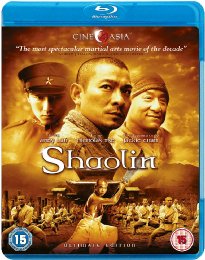






































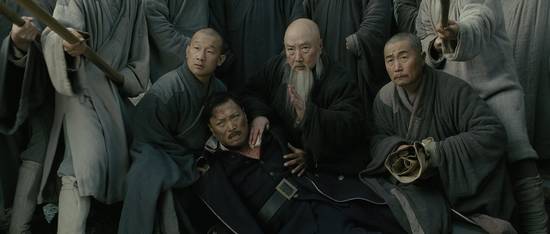

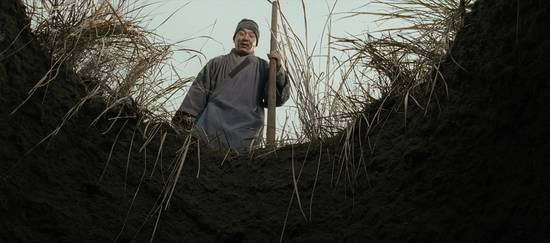
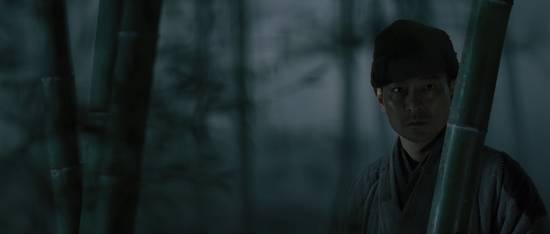
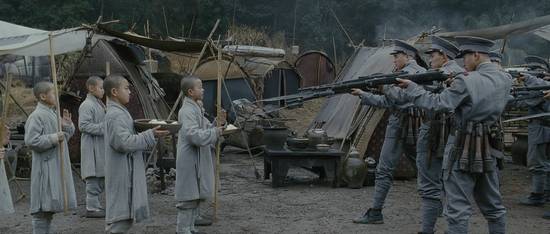
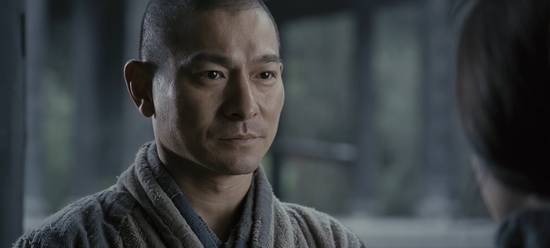
Your Opinions and Comments
Be the first to post a comment!